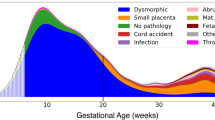Abstract
Prenatal ductal constriction and closure usually are related to maternal intake of prostaglandin receptor inhibitors during late gestation but may occur spontaneously. This report describes three live-born infants sharing echocardiographic features of spontaneous intrauterine ductal constriction, closure, or both, although only one had a prenatal diagnosis. Interestingly, in addition to severely hypertrophied right ventricles, all three had hyperechogenic tricuspid valve papillary muscles. Two also had mild ascending aorta dilation. These cases raise mechanistic questions because of intrauterine ductal occlusion, bright papillary muscles, and potential dilated ascending aortas.



Similar content being viewed by others
References
Alehan D, Dogan OF (2005) Right ventricular noncompaction in a neonate with complex congenital heart disease. Cardiol Young 15:434–436
Hofstadler G, Tulzer G, Altmann R et al (1996) Spontaneous closure of the human fetal ductus arteriosus: a cause of fetal congestive heart failure. Am J Obstet Gynecol 174:879–883
Kondo T, Kitazawa R, Noda-Maeda N, Kitazawa S (2006) Fetal hydrops associated with spontaneous premature closure of ductus arteriosus. Pathol Int 56:554–557
Koren G, Florescu A, Costei AM et al (2006) Nonsteroidal antiinflammatory drugs during third trimester and the risk of premature closure of the ductus arteriosus: a meta-analysis. Ann Pharmacother 40:824–829
Levin DL, Mills LJ, Weinberg AG (1979) Hemodynamic, pulmonary vascular, and myocardial abnormalities secondary to pharmacological constriction of the fetal ductus arteriosus: a possible mechanism for persistent pulmonary and transient insufficiency in the newborn infant. Circulation 60:360–364
Lim KA, Huh J, Jun T (2004) Successful repair of critical tricuspid regurgitation secondary to ruptured papillary muscle in the newborn. Cardiol Young 14:450–452
Moise KJ, Huhta JC, Sharif DS et al (1988) Indomethacin in the treatment of premature labor: effects on the fetal ductus arteriosus. N Engl J Med 319:327–331
Paladini D, Marasini M, Volpe P (2005) Severe ductal constriction in the third-trimester fetus following maternal self-medication with nimesulide. Ultrasound Obstet Gynecol 25:357–361
Reese J, Anderson JD, Brown N et al (2006) Inhibition of cyclooxygenase isoforms in late- but not midgestation decreases contractility of the ductus arteriosus and prevents postnatal closure in man. Am J Physiol Regul Integr Comp Physiol 291:1717–1723
Sachdeva R, Fiser RT, Morrow WR et al (2007) Ruptured tricuspid valve papillary muscle: a treatable cause of neonatal cyanosis. Ann Thorac Surg 83:680–682
Schiessl B, Schneider KTM, Zimmermann A et al (2005) Prenatal constriction of the fetal ductus arteriosus—related to maternal pain medication? Z Geburtsh Neonatol 209:65–68
Shehata BM, Bare JB, Denton TD et al (2006) Premature closure of the ductus arteriosus: variable response among monozygotic twins after in utero exposure to indomethacin. Fetal Pediatr Pathol 25:151–157
Tennstedt C, Chaoui R, Vogel M et al (2000) Pathologic correlation of sonographic echogenic foci in the fetal heart. Prenat Diagn 20:287–292
Vermillion ST, Scardo JA, Lashus AG, Wiles HB (1997) The effect of indomethacin tocolysis on fetal ductus arterious constriction with advancing gestational age. Am J Obstet Gynecol 177:256–259
Yokoyama U, Minamisawa S, Quan H et al (2006) Chronic activation of prostaglandin receptor EP4 promotes hyaluronan-mediated neointimal formation in the ductus arteriosus. J Clin Invest 116:3026–3034
Author information
Authors and Affiliations
Corresponding author
Rights and permissions
About this article
Cite this article
Nygaard, S.I., Petersen, O.B., Garne, E. et al. Spontaneous Prenatal Ductal Closure: Postnatal Diagnosis?. Pediatr Cardiol 30, 176–180 (2009). https://doi.org/10.1007/s00246-008-9269-1
Received:
Revised:
Accepted:
Published:
Issue Date:
DOI: https://doi.org/10.1007/s00246-008-9269-1




